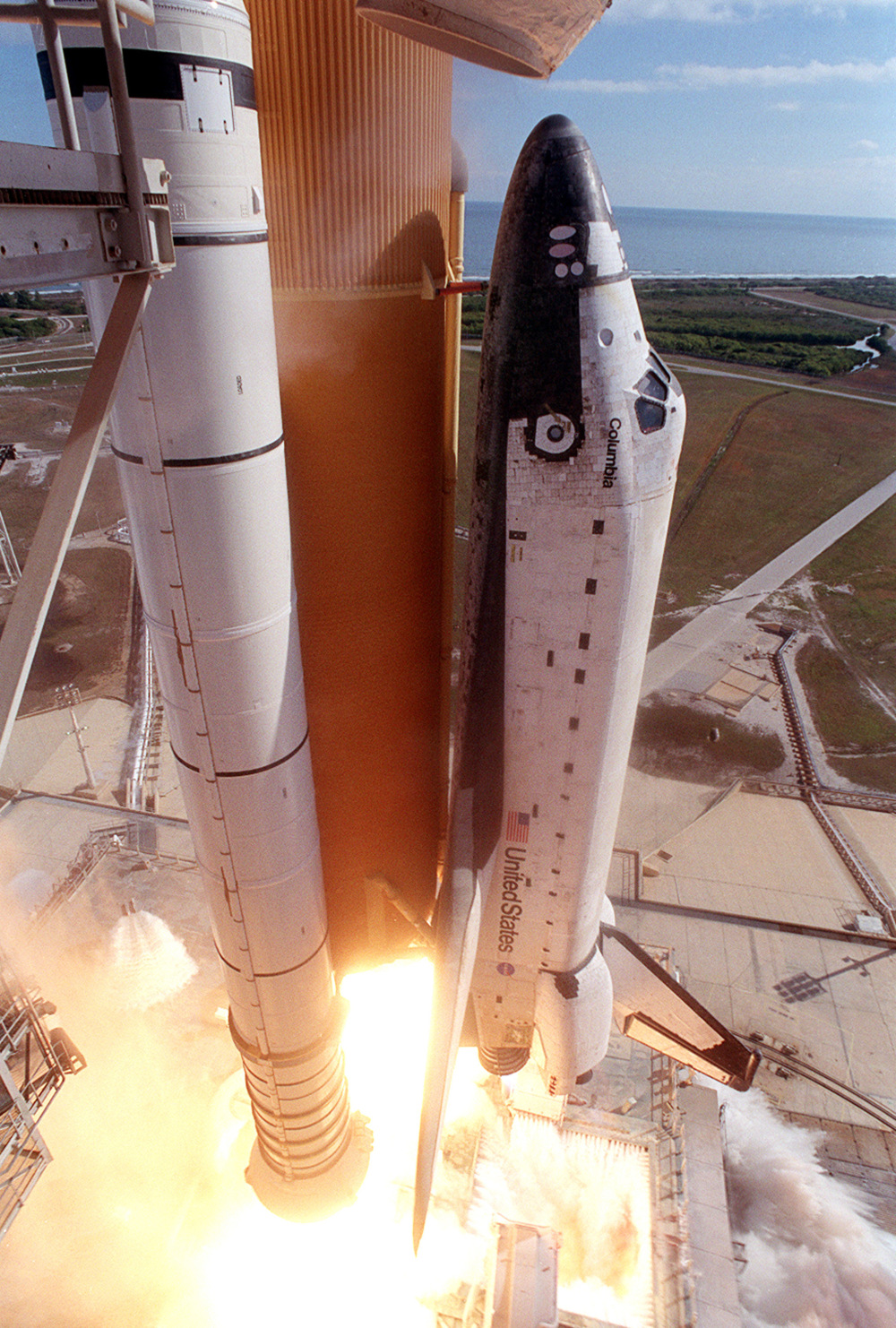The opposite of solid is liquid.
Back before the 1900s, the only type of rocket fuel used was solid. Then, in 1926, Robert Goddard flew a very small rocket named Nell, after his daughter. This rocket had the distinction as being the first rocket to use liquid propellant. It reached the amazing height of about 100 meters. Not super high, but it was really a “Wright Brothers” moment. Nothing would be the same.
 Robert Goddard with his rocket Nell.
Robert Goddard with his rocket Nell.
An aside on Robert Goddard: Goddard was basically the father of modern rocketry. When the press found out what he had done, they interviewed him and actually made fun of him, because they didn’t understand how rockets work. They thought that the rocket exhaust pushed on the atmosphere, enabling the rockets to go. They did not understand that you don’t need an atmosphere, or the ground, to lift something into space. In fact, the New York Times printed an editorial about Goddard that stated that he “does not know the relation of action and reaction, and of the need to have something better than a vacuum against which to react—to say that would be absurd. Of course he only seems to lack the knowledge ladled out daily in high schools.” Oops. That journalist didn’t read this blog, where I explain that rockets go because of Newton’s laws of motion. Goddard became very withdrawn and basically did his research in private. But, people still knew about him. In fact, German rocket scientists knew about him. They would call him up and ask him about different aspects of rockets. Being a scientist, he would share what he knew. Being an American, he told the government about the German’s interest in rocketry, which the government ignored. Robert Goddard died in August 1945. Just north of Washington DC, there is the NASA Goddard Research Facility, where scientists and engineers build many of the satellites that are in orbit today. The New York Times published an apology to Goddard the day after the launch of Apollo 11, which stated “Further investigation and experimentation have confirmed the findings of Isaac Newton in the 17th Century and it is now definitely established that a rocket can function in a vacuum as well as in an atmosphere. The Times regrets the error.”
An example of a liquid fuel for rocketry is hydrogen with oxygen used as an oxidizer. When these two molecules are mixed together, they release a very large amount of energy, and water results. I am sure that you all know that oxygen is a gas at room temperature, and I am sure that many of you know that hydrogen is also a gas at room temperature. Why, therefore, is this post about liquids and not gasses? Well, a gas takes up a huge amount of space compared to a liquid. Oh, sure, you could store gasses in pressure tanks, but have you ever tried to lift a gas tank? They are extremely heavy, since they have to hold the massive pressures of the gasses. So, the rockets would have to be very, very heavy in order to hold all of the gas. It is much easier to cool the gas down to extremely low temperatures and cause them to liquify. Then, you can store the liquids in relatively light weight tanks.
A liquid propellent engine typically uses two different liquids, a fuel and an oxidizer to create a large amount of energetic (hot) gas that is expelled at extremely fast speeds. The liquids need to be kept in separate tanks to keep them apart until they are pumped into the combustion chamber. The word “pumped” is important here, since, the flow rate of a pump can be controlled. This means that a liquid rocket engine can be throttled, such that the burn-rate of the propellent can be controlled, unlike a solid rocket booster. In fact, the liquid can be cut off completely, stopping all thrust. The flow can then be resumed at a later time, allowing the engine to restart. These are huge advantages over solid rocket boosters.
Liquid propellents are typically more efficient that solid propellents. This means that less fuel is needed, and since the amount of fuel exponentially increases as more is needed (see the rocket equation post!), any increase in fuel efficiency can dramatically decrease the size of the rocket.
Why would anyone ever use a solid propellent rocket, then? Well, there are a few disadvantages to liquid fueled rockets.
The first is that the liquids typically have to be stored at an extremely cold temperature. For example, oxygen turns into a liquid at -183 C (-297F). It is not super easy to store, nor is it super easy to fuel the rocket. Also, the rocket sits on the ground for a while before being launched into space, so there sometimes is insulation on the storage tank. For example, the large orange thing on the space shuttle is not rocket, but is a storage tank for the liquid oxygen and hydrogen. It is orange because that is the color of the foam insulation that wraps the entire tank. This insulation was the direct cause of the Columbia accident in 2003. I will talk about this in a separate post.
 The Space Shuttle Columbia during its final launch. The orange thing that the shuttle is attached to is the storage tank for the liquid hydrogen and oxygen. It is orange because the tank is completely covered in several inches of (orange) foam insulation.
The Space Shuttle Columbia during its final launch. The orange thing that the shuttle is attached to is the storage tank for the liquid hydrogen and oxygen. It is orange because the tank is completely covered in several inches of (orange) foam insulation.
There is one advantage of having super-cooled liquids on the rocket, though. The combustion chamber and the rocket’s nozzle can get extremely hot, since the whole point of the rocket engine is to make extremely hot gasses and direct them out of the nozzle. The combustion chamber and nozzle can actually melt because of this. But, because there is very cold liquid around, the rocket’s plumbing goes around the nozzle and combustion chamber before leading into the chamber. This cools down the extremely hot metal, and warms up the liquids before they are combined together. All of this plumbing and pumping makes liquid engines much more complicated than solid engines.
Another disadvantage of liquid propellents is the storage tanks. Imagine trying to ride a bike with a half-empty five-gallon bucket of water balanced on your handlebars. As the water slushes around, it moves the center of gravity around. If you are trying to go in a (relatively) straight line, and stay balanced, this can significantly complicate things. The same is true with a liquid propellent rocket. The tanks move from being full, to being empty, with every stage in between. All the while, the rocket has to stay on course. The tanks, therefore, need to have baffles and be specially designed so that the liquids won’t slosh. Yet another complication.
If you drove a car before about 1995, you probably remember having a carburetor. These were devices that combined the fuel with oxygen. Now, pretty much all cars have fuel injectors that automatically adjust the amount of fuel and oxygen mixture. So, imagine 50 years before the first automobile fuel injectors were built, building them for rockets. The fuel and the oxidizer had to be mixed just right in order for the burn to be as efficient as possible. On the Saturn-V, the fuel was being used at such a huge rate, that they couldn’t get the mixture to be very good, so they ended up having pockets of fuel and oxidizer, which would then cause explosions. The engineers didn’t have time to develop new fuel injectors, so they made the walls of the combustion chamber thicker in order to withstand the explosions. Engineering! Fuel injectors are complicated when you are using hundreds of gallons of fuel a second. Today, fuel injector technology is much better, but we don’t have many rockets that use fuel as quickly as a Saturn-V did.
In summary, liquid fueled rockets have some big advantages over solid rockets, namely the engines can be throttled and even turned off, allowing more precise orbital insertion; and the liquid fuels tend to be more efficient than solid fuels. On the other hand, rockets that use liquids as fuels tend to be more complicated, with lots of pumps, massive plumbing systems, and fuel injectors. Most rockets that launch satellites into space tend to have a main stack that is liquid with strap-on solid boosters that provide a bit of extra lift in the first minutes of the launch. That way the rockets compromise between the simplicity, but reduced performance of the solid rockets, while allowing the complex, but precise orbital insertion and raw power of the liquid fueled rockets.
Photos:
- By Esther C. Goddard – Great Images in NASA, Public Domain, https://commons.wikimedia.org/w/index.php?curid=56731
- NASA – http://grin.hq.nasa.gov/ABSTRACTS/GPN-2003-00080.html






